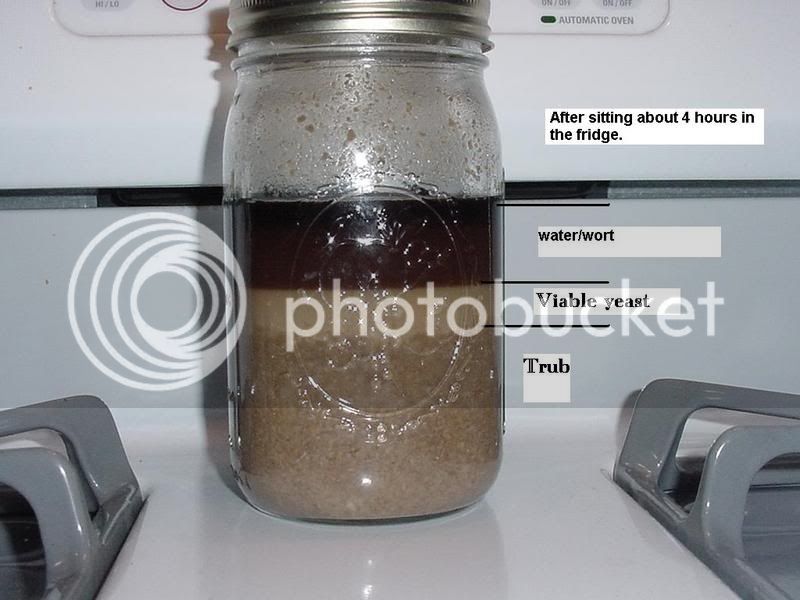PistolPatch
Well-Known Member
- Joined
- 29/11/05
- Messages
- 2,717
- Reaction score
- 44
Here is a pic of a 1lt jar of some yeast cake I collected last night. Hopefully you will see 3 layers, trub etc at bottom, a fine diagonal line of white (thicker on the right) which apparently is the yeast :blink and above that basically water.
and above that basically water.

I added about 600ml of coiled boiled water to the fermenter before collection to help loosten the yeast cake as bugger all beer was left. I often do this.
My problem is that I have recently done more reading. The method I used to use (which I'll list below has worked well and I got it here on AHB) but on further reading, including Palmer, it looks as though I have been doing it all wrong.
My main question obviously is what should I do with this jar now? The jar is now at 2 degrees and it's 24 hrs later? But before this can be answered, I'd love my two questions at the end here answered.
My Old Method...
Previously, I would tip all the top stuff off (which probably included the top layer of what I now find out to be yeast.) I would repeat this several times with cooled boiled water until all the stuff on top appeared clear. With the remaining stuff, (the stuff at the bottom) I'd just leave it in my fridge until I needed it whether that be two weeks or two months later.
Before pitching, I'd taste it and smell it. Any doubts and she was out the door. I would add about 200mls to my brew and it always kicked off perfectly and gave me top results. Using this method, I got a lot over 6 months out of a single yeast packet.
Now I Read That...
Upon a little further reading recently, including Palmer, I find that theoretically in my above washing process, I have actually been washing away the yeast!!!!
Q1. Why has my existing method worked so well if I have theoretically been washing the yeast away?
Q2. If I use Palmer's method, how do I get the water part clear without losing all the yeast?
My yeast from my yeast cake needs to be used anywhere from a week to a few months.
Hope you guys can help me out here.
Spot ya,
Pat

I added about 600ml of coiled boiled water to the fermenter before collection to help loosten the yeast cake as bugger all beer was left. I often do this.
My problem is that I have recently done more reading. The method I used to use (which I'll list below has worked well and I got it here on AHB) but on further reading, including Palmer, it looks as though I have been doing it all wrong.
My main question obviously is what should I do with this jar now? The jar is now at 2 degrees and it's 24 hrs later? But before this can be answered, I'd love my two questions at the end here answered.
My Old Method...
Previously, I would tip all the top stuff off (which probably included the top layer of what I now find out to be yeast.) I would repeat this several times with cooled boiled water until all the stuff on top appeared clear. With the remaining stuff, (the stuff at the bottom) I'd just leave it in my fridge until I needed it whether that be two weeks or two months later.
Before pitching, I'd taste it and smell it. Any doubts and she was out the door. I would add about 200mls to my brew and it always kicked off perfectly and gave me top results. Using this method, I got a lot over 6 months out of a single yeast packet.
Now I Read That...
Upon a little further reading recently, including Palmer, I find that theoretically in my above washing process, I have actually been washing away the yeast!!!!
Q1. Why has my existing method worked so well if I have theoretically been washing the yeast away?
Q2. If I use Palmer's method, how do I get the water part clear without losing all the yeast?
My yeast from my yeast cake needs to be used anywhere from a week to a few months.
Hope you guys can help me out here.
Spot ya,
Pat






